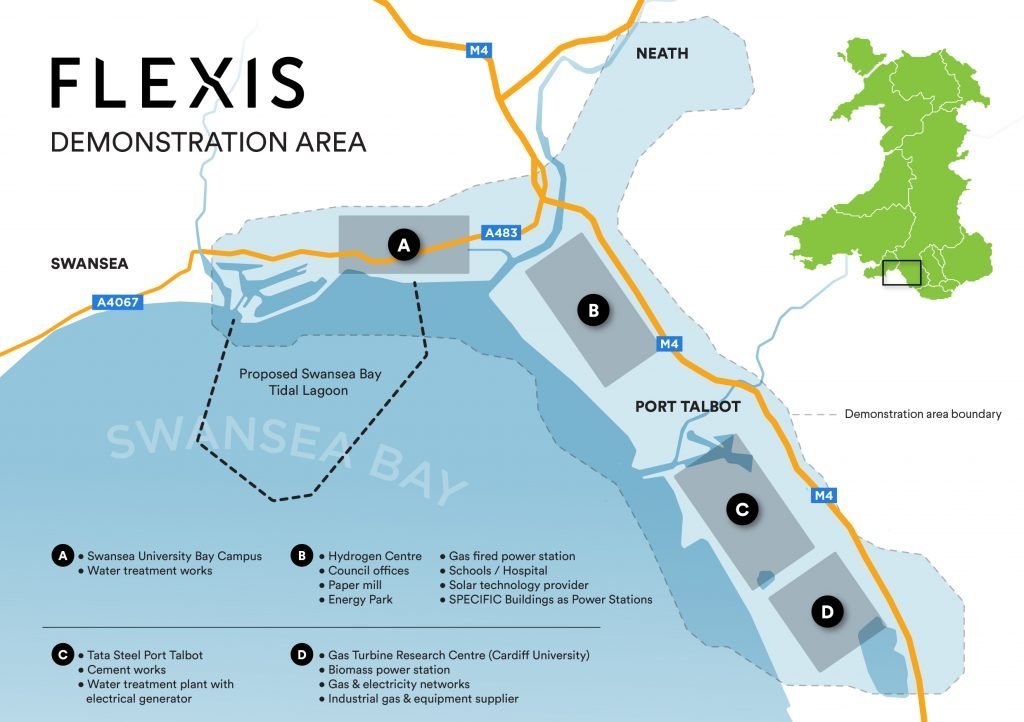Decarbonisation of heat – Using FLEXIS demo area techniques to benefit all of South Wales

Techniques developed to estimate domestic heat demand within the FLEXIS Demonstration Area in Port Talbot are now powering research into decarbonisation across all South Wales. Researchers from Work Package 1 with Professor Nicholas Jenkins are working to support the Zero2050 initiative. Led by National Grid, Zero2050 aims to speed up the progress of the decarbonisation of South Wales to hit net-zero 2050 targets.
Cardiff University’s Dr Meysam Qadrdan, Alexandre Canet and William Seward are part of a team looking specifically at how heat demand will change between now and 2050, for both the domestic and nondomestic sectors. The outcomes of this research will help inform the energy industry in how to best make investments to cope with future energy demand, such as reinforcements to the electric grid.
Exploring different versions of the future
The researchers are investigating three different heating scenarios that could each provide a route to net-zero. The first among the three scenarios is based around Hydrogen Heating. Like today’s natural gas boilers, hydrogen boilers can provide large injections of instantaneous heating but without emitting the greenhouse gasses associated with burning natural gas. However, the hydrogen used to fuel the boilers needs to be produced in a low carbon way if it is to have the best possible impact on overall emissions.
The second scenario focuses on the electrification of heating. The model incorporates widespread use of heat pumps in every possible application and district heating in high density areas. District heating is usually characterised by buildings receiving hot water as part of a local network where the water is heated at a central facility. South Wales provides interesting opportunities for low carbon district heating in the form of heat from mine water or waste heat from industrial processes. Overall impact on decarbonisation in this scenario is heavily dependent on a low carbon electric grid.
The final scenario is a hybrid model that investigates a mix of hydrogen boilers and air source heat pumps. The two technologies can also be used in conjunction with each other, known as a ‘hybrid heat-pump’, where an air source heat pump works is combination with a hydrogen boiler which allows for switching between hydrogen and electricity based on external signals such as outside air temperature and electricity prices.

Heat decarbonisation scenarios for Swansea (HP: Heat Pump, DH: District Heating)
From demo area to region wide
To build the best possible models of each scenario, the researchers would ideally like to accurately predict heat demand per-building. However, the availability of good quality, detailed data makes that process difficult.
Alexandre Canet has been working closely with Wales and West Utilities to validate his predictions. If the predictions on heat demand per-building are accurate, then scaling those numbers up over a larger area should compare closely to the actual gas demand for a county or city level measured each year.
To get a more detailed assessment of heat demand, the team leveraged prior research from the FLEXIS Demonstration Area in Neath Port Talbot. The technique developed as part of that research leveraged small geographic regions or Lower Layer Super Output Areas (LSOAs) from census data which could be used to define a lower level of granularity than just predicting heat demand per city or county.
The makeup of buildings inside the LSOAs can then be paired with Energy Performance Certificate data. By using the energy efficiency data, the buildings were classified into 16 archetypes combining dwelling shapes with heating systems; for example detached, semi-detached, terraced and apartments, and heating technologies such as gas boiler, electric resistance heater, oil boiler and biomass boiler. For each archetype, an average annual heat demand was calculated using the information on annual heat demand of individual buildings reported in their EPC. The total heat demand in a LSOA was calculated by adding annual heat demand for different combination of building archetype and heating technologies.
Using models to predict future demand
Using the predictions for heat demand per LSOA allows the team to model the current and future heat demand at a level of geographic detail that can inform activities like reinforcement of the electric grid or the installation of district heating schemes.

Intensity maps of the estimated domestic heat demand by LSOA in 2018
Steering the course to net-zero
The outcomes of the Cardiff University work will be combined with the work from other partners of the Zero2050 project, which includes analysis of the industry and transport sectors to provide a full picture of what a net-zero South Wales could be. With the Welsh Government as a partner, the final report aims to inform the development of new policies and activities to reach the net-zero target, and findings from this initiative could be transposed nationwide and leveraged in other projects.


